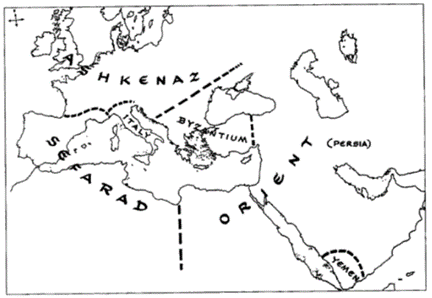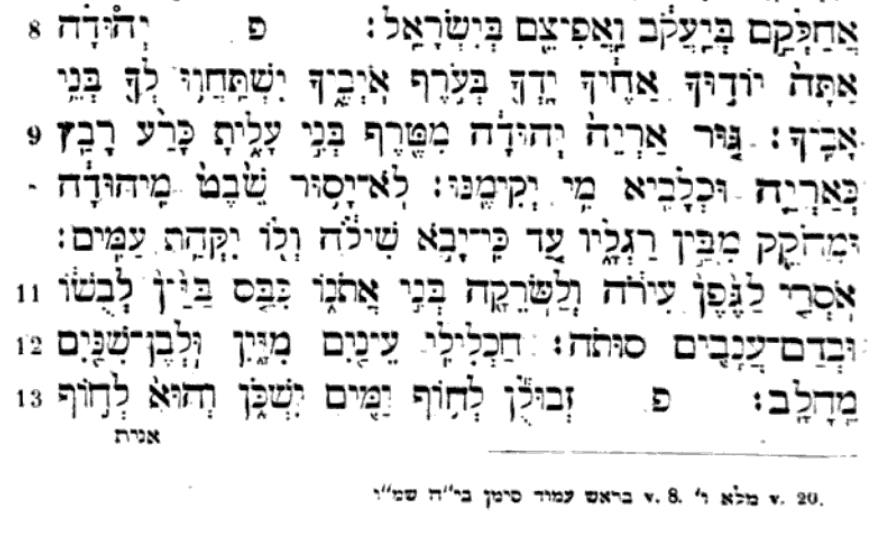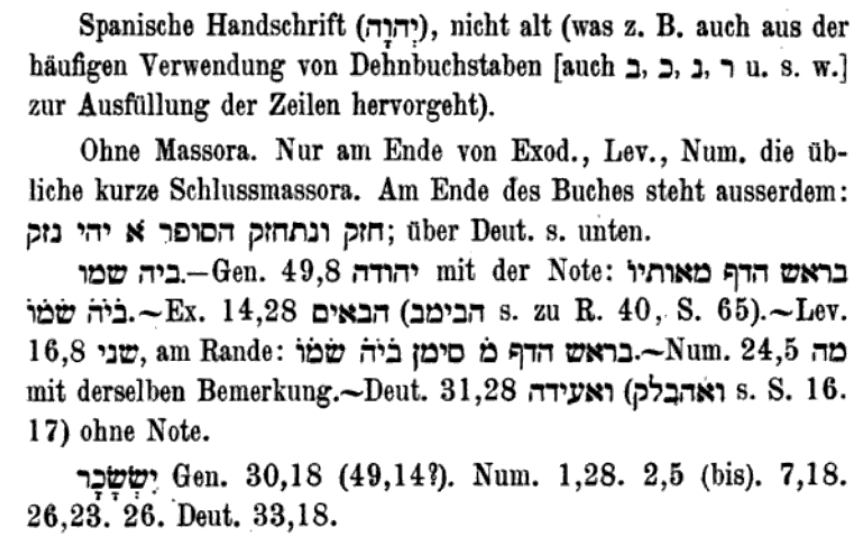How are the columns of a Torah scroll to be laid out? There are actually two separate traditions at play here, i.e. ווי העמודים (vavei ha'amudim) - the practice of heading every column possible with a vav - and בי''ה שמ''ו. It is well established that in a vavei ha'amudim Torah scroll, there are 5 columns which do not begin with a vav. These five begin with the letters beit, yod, hey, shin, and mem - in that order. There is one vav column after this sequence which always begins with the same word, hence the acronym בי''ה שמ''ו - a phrase taken from Tehillim 68:5. What is perhaps less well known is that these column heads are used regardless of whether a Sefer Torah is written vavei ha'amudim or not, but where in the text these letters lead varies by tradition, i.e. Ashkenaz, Western Sephardic, Mizrahi, Teimani, and Italian.

The Appeal of the Vavei Ha'amudim Tradition
The popularity of the ווי העמודים (vavei ha'amudim) practice lies in its beauty as a "visual midrash." As a prefix, the letter vav most often means "and" - hence it is the letter of connection. According to this practice, each column (עמוד) of the Sefer Torah must begin with the letter vav (וו). The term ווי העמודים appears in the Torah both at Shemot 27:10-11 and at 38:10-12, 17 - both passages describing the construction of the Mishkan.
(י) וְעַמֻּדָ֣יו עֶשְׂרִ֔ים וְאַדְנֵיהֶ֥ם עֶשְׂרִ֖ים נְחֹ֑שֶׁת וָוֵ֧י הָעַמֻּדִ֛ים וַחֲשֻׁקֵיהֶ֖ם כָּֽסֶף׃ (יא) וְכֵ֨ן לִפְאַ֤ת צָפוֹן֙ בָּאֹ֔רֶךְ קְלָעִ֖ים מֵ֣אָה אֹ֑רֶךְ וְעַמֻּדָ֣ו עֶשְׂרִ֗ים וְאַדְנֵיהֶ֤ם עֶשְׂרִים֙ נְחֹ֔שֶׁת וָוֵ֧י הָֽעַמֻּדִ֛ים וַחֲשֻׁקֵיהֶ֖ם כָּֽסֶף׃
(10) with its twenty posts and their twenty sockets of copper, the hooks and bands of the posts to be of silver. (11) Again a hundred cubits of hangings for its length along the north side—with its twenty posts and their twenty sockets of copper, the hooks and bands of the posts to be of silver.
(י) עַמּוּדֵיהֶ֣ם עֶשְׂרִ֔ים וְאַדְנֵיהֶ֥ם עֶשְׂרִ֖ים נְחֹ֑שֶׁת וָוֵ֧י הָעַמּוּדִ֛ים וַחֲשֻׁקֵיהֶ֖ם כָּֽסֶף׃ (יא) וְלִפְאַ֤ת צָפוֹן֙ מֵאָ֣ה בָֽאַמָּ֔ה עַמּוּדֵיהֶ֣ם עֶשְׂרִ֔ים וְאַדְנֵיהֶ֥ם עֶשְׂרִ֖ים נְחֹ֑שֶׁת וָוֵ֧י הָֽעַמּוּדִ֛ים וַחֲשֻׁקֵיהֶ֖ם כָּֽסֶף׃ (יב) וְלִפְאַת־יָ֗ם קְלָעִים֙ חֲמִשִּׁ֣ים בָּֽאַמָּ֔ה עַמּוּדֵיהֶ֣ם עֲשָׂרָ֔ה וְאַדְנֵיהֶ֖ם עֲשָׂרָ֑ה וָוֵ֧י הָעַמֻּדִ֛ים וַחֲשׁוּקֵיהֶ֖ם כָּֽסֶף׃
(10) with their twenty posts and their twenty sockets of copper, the hooks and bands of the posts being silver. (11) On the north side, a hundred cubits—with their twenty posts and their twenty sockets of copper, the hooks and bands of the posts being silver. (12) On the west side, fifty cubits of hangings—with their ten posts and their ten sockets, the hooks and bands of the posts being silver.
(יז) וְהָאֲדָנִ֣ים לָֽעַמֻּדִים֮ נְחֹ֒שֶׁת֒ וָוֵ֨י הָֽעַמּוּדִ֜ים וַחֲשׁוּקֵיהֶם֙ כֶּ֔סֶף וְצִפּ֥וּי רָאשֵׁיהֶ֖ם כָּ֑סֶף וְהֵם֙ מְחֻשָּׁקִ֣ים כֶּ֔סֶף כֹּ֖ל עַמֻּדֵ֥י הֶחָצֵֽר׃
(17) The sockets for the posts were of copper, the hooks and bands of the posts were of silver, the overlay of their tops was of silver; all the posts of the enclosure were banded with silver.—
The idea is that the Sefer Torah is as filled with the Shekinah (Presence of Hashem) as was the Mishkan.
(ז) מִשְׁכַּן הָעֵדֻת, מָה הָעֵדֻת, זוֹ תּוֹרָה שֶׁהֵם יְגֵעִים בָּהּ.
(7) “The Tabernacle of Testimony” (Exodus 38:21): What is the testimony? This is the Torah in which [Israel] toils....
The parallels extend even into the terms which we use to describe certain physical elements of the Torah scroll. Just as the “curtains” (יריעות) of the Mishkan (Tabernacle) were held up by the “hooks” (ווים) at the top of the “pillars” (עמודים), so too the “panels or sheets” (יריעות) of the Sefer Torah should be held up by the “hooks” (ווים) at the top of the “columns” (עמודים). The vav on top of each column is thus emblematic of the Torah's unity.
יריעות
Mishkan: the curtains that comprise the walls of the Mishkan
Sefer Torah: the panels or sheets of a Sefer Torah
עמודים
Mishkan: the pillars which provide the frame for the Mishkan
Sefer Torah: the columns of text; synonymous with dappim (דפים)
ווים
Mishkan: the hooks attached to the pillars from which the curtains hang
Sefer Torah: the 6th letter of the Hebrew aleph-beit; as a word unto itself having the meaning of "hook"
The vavei ha'amudim practice is mentioned in Shulchan Arukh and Tikkunei Zohar, and its present advocates include scribes in both the Ashkenazic and Sephardic communities. Among them is the 19th century halakhist Rabbi Yechiel Michel Epstein, who opines:
(כד) ... וכבר נהגו הסופרים לכתוב אחריו. ובוודאי שנכון וישר לעשות כן, ויש בזה עניין גדול.
... The scribes already practice this tradition and it is absolutely correct and proper to continue it: this is a very important matter.

Opposition to the Vavei Ha'amudim Tradition
Despite its present popularity (in nearly all Sifrei Torah since about 1870), there is no mention of the practice in either the Talmud or the Mishneh Torah (Rambam). The fact that there was strong opposition to the vavei ha'amudim tradition at a few points in Jewish halakhic history, however, indicates its use far earlier. Rabbi Meir ben Yekutiel haKohen, the Maharam of Rothenburg (1260-1298), attacked the practice in his work Hagahot Maimoni, affirming that it was already being practiced by some in the late 13th century. His criticism was as follows:
ר' מעיר רותנברג, הגדות מימוני, הלכות ספר תורה ז':ז'
מה שנהגו סופרים בורים להתחיל כל עמוד בוי”ו וקורין לו וו”י העמודים נראה שאיסור גמור יש בדבר שהרי עושים העמודים יש מהן רחב ויש מהן קצר ופעמים יש אותיות גדולות אשר לא כדת... ופעמים אותיות משונות וארוכות הרבה כדי שיגיע וי”ו לראש כל עמוד... ולא נכון בעיני כמו שכתבת ואינם לא מדברי תורה ולא מדברי סופרים אך סופר אחד היה ר’ ליאונטיין ממילהוז”ן שהראה אומנתו ואילו היה לי לכתוב ספר תורה הייתי נזהר שלא היה שום עמוד מתחיל בוי”ו חוץ מואעידה בם עכ”ל:
R' Meir of Rothenburg, Hagadot Maimoni, Hilkhot Sefer Torah 7:7
The current practice of ignorant scribes to begin each column with a vav, and which they call vavei ha-amudim appears to be completely prohibited. For those who make these columns, some are wide and some are narrow; sometimes the letters are too big…. Sometimes the letters appear strange and too long, in order to allow a vav to appear at the top of each column…. The custom is not found in the Torah or scribal tradition. Instead, there was one scribe named Rabbi Leontin of Mühlhausen [ליאונטיין ממילהוז''ן],1 who was showing off his abilities. Were I to write a Torah scroll, I would make sure that no column begins with a vav, except for ואעידה בם ‘and I will call witness against them’ (Deut 31:28).
Shlomo Ganzfried writes in 1835 expressing that he shares in opining thus, citing Benei Yonah:2
(ה) ... אבל מה שנהגו קצת לכתוב בראש כל עמוד וי"ו וקורין אותו ווי העמודים יש לבטל שלא לעשות כן. כי מתוך כך באים לידי קלקול שמרחיבים ומקצרים אותיות שלא כרת. ואפילו מי שיוכל לכוין שלא יצטרך להרחיב ולקצר באותיות יש לו למנוע מלעשות כן. מפני שממנו ילמדו אחרים לעשות ג"כ כמוהו והם לא יוכלו לכוין וירחיבו וירחקו באותיות כאות נפשם (בני יונה):
(5) ... Some have the custom to start each column with a vav – calling it vavei ha׳amudim; this should be discouraged, because the letters are so squashed and stretched to achieve it that it comes to be written incorrectly and spoiled. Even if one can do it without unduly squashing and stretching the letters, he should still refrain, because other people will think that they can do it too, even if they cannot space their writing properly, and they will squash and stretch letters just as they please (Benei Yonah).
Sources for the בי''ה שמ''ו Tradition
(ה) שִׁ֤ירוּ ׀ לֵאלֹהִים֮ זַמְּר֢וּ שְׁ֫מ֥וֹ סֹ֡לּוּ לָרֹכֵ֣ב בָּ֭עֲרָבוֹת בְּיָ֥הּ שְׁמ֗וֹ וְעִלְז֥וּ לְפָנָֽיו׃
(5) Sing to God, chant hymns to His name; extol Him who rides the clouds; the LORD is His name. Exult in His presence—
In the Gaonic era, there developed a custom of heading six columns of the Torah with specific words beginning with the letters which spell out the phrase ביה שמו. Which words these are, and from which verses, varies by tradition. There seems to have developed from this at some point a short-lived practice of beginning every column of the Torah with one of these six letters, before that custom gave way to the more common exercise of aligning the text according to vavei ha'amudim.
Shlomo Ganzfried's Keset HaSofer (op. cit.), which continues to be a primary resource for Ashkenaz soferim, delineates the columns for three traditions, i.e. the Ashkenaz, Western Sephardic, and Italian traditions.
(ה) יש סופרים מדקדקין לכתוב בי"ה שמ"ו בראש העמוד. פירוש ב' דבראשית יו"ד יהודה אתה. ה' הבאים אחריהם (בפ' בשלח קודם השירה) ש' שמר לך (בפ' כי תשא) וי"א שני השעירים גרלות (אחרי מות ט"ז ח') וי"א שמר ושמעת (בפ' ראה) מ' מה טבו. וי"א מוצא שפתיך (בפ' תצא) ו' ואעירה בם. ובדיעבד אם לא כתבן כן אינו מעכב.
(5) Some scribes are careful always to start columns with one of the letters beis, yod, hey, shin, mem, and vav. That is, beis from Bereshis; yod from Yehudah ata (Gen 49:8); hey from habaim achareihem (Ex. 14:28); shin from shmar lekha (Ex. 34:11 [Ashkenaz]) – some say from shnei ha-se-irim goralot (Lev 16:8 [Western Sephardic]) and some say from Shmor ve-shama-ta (Deut 12:28 [Italian]); mem from mah tovu (Num 24:5 [Ashkenaz, Western Sephardic), and some say from motza sfateikha (Deut 23:24 [Italian]); and vav from v'aidah bam (Deut 31:28). Post facto, if one did not write it this way, it is not invalid.
ב: Sources on the beit of b'reshit (B'reshit 1:1) seem unnecessary, given that it is the very first word of the Torah. There is no way the first column could begin with a vav without changing the text of B'reshit.
י: As indicated in Keset HaSofer above, the yod column is the same across all the traditions addressed therein. The Baladi Rite Teimani align with the Yehudah tradition as well.3 The Masora Magna makes note of this (shown below).

There is one exception, i.e. that in the Mizrahi tradition, instead of Yehudah of B'reshit 49:8, the column head is Yissachar of B'reshit 49:14. Note the last two lines in the image below noting the exception to the yod rule.4

ה: The hey column is the same across all traditions. It comes at the column which contains the Shirat haYam (Shemot 15), and it is a long-established rule that this column must begin with five lines of text from chapter 14 and a blank line before the shirah begins. We see this already from the Rambam:
(י) יֵשׁ דְּבָרִים אֲחֵרִים שֶׁלֹּא נֶאֶמְרוּ בַּגְּמָרָא וְנָהֲגוּ בָּהֶם הַסּוֹפְרִים וְקַבָּלָה הוּא בְּיָדָם אִישׁ מִפִּי אִישׁ. וְהֵן שֶׁיִּהְיוּ מִנְיַן הַשִּׁיטִין שֶׁבְּכָל דַּף וְדַף לֹא פָּחוֹת מִשְּׁמוֹנָה וְאַרְבָּעִים וְלֹא יָתֵר עַל שִׁשִּׁים. וְשֶׁיִּהְיֶה הָרֶוַח שֶׁבֵּין פָּרָשָׁה לְפָרָשָׁה כְּמוֹ תֵּשַׁע אוֹתִיּוֹת אֲשֶׁר אֲשֶׁר אֲשֶׁר. וְשֶׁיִּהְיֶה בְּרֹאשׁ הַשִּׁיטִין לְמַעְלָה מִשִּׁירַת הַיָּם (שמות יד כח לא) ״הַבָּאִים. בַיַּבָּשָׁה. הַשֵּׁם. מֵת. בְּמִצְרַיִם״. חָמֵשׁ שִׁיטִין. וּלְמַטָּה מִן הַשִּׁירָה חָמֵשׁ שִׁיטִין תְּחִלַּת כָּל שִׁיטָה מֵהֶן כָּךְ. (שמות טו כ כג) ״וַתִּקַּח. אַחֲרֶיהָ. סוּס. וַיֵּצְאוּ. וַיָּבֹאוּ״. וְיִהְיֶה בְּרָאשֵׁי הַשִּׁיטִין לְמַעְלָה מִשִּׁירַת הַאֲזִינוּ. (דברים לא כט ל) ״וְאָעִידָה. אַחֲרֵי. הַדֶּרֶךְ. בְּאַחֲרִית. לְהַכְעִיסוֹ. קְהַל״. שֵׁשׁ שִׁיטִין. וּלְמַטָּה מִמֶּנָּה חָמֵשׁ שִׁיטִין (דברים לב מד מז) ״וַיָּבֹא. לְדַבֵּר. אֲשֶׁר. הַזֹּאת. אֲשֶׁר״:
(10) There are other rules mentioned in the Talmud which the scribes observe as a tradition handed down from one to another. They are as follows: The number of lines in each column shall not be less than forty-eight and not more than sixty; the blank spaces between one section and another shall be such that nine letters, e.g., aleph-shin-resh, aleph-shin-resh, aleph-shin-resh, can be written in it. The five lines preceding the Song at the Red Sea (Exodus 14:28, 29, 30, 30, 31) shall begin respectively with the words Habaim, Bayabashah, Hashem, Mes, Bemitzraim. The five lines after it shall begin respectively with the words Vatikach, Achareha, Sus, Vayetzëü, Vayavöü (Exodus 15:20, 20, 21, 22, 23). The six lines before the Song of Moses beginning Haazinu (Deuteronomy 32:1-43) shall respectively commence with the words Veaeedah, Acharé, Haderech, Beacharith, Lehacheeso, Kehal (Deuteronomy 31:28, 29, 29, 29, 29, 30); and the five lines after the Song of Moses shall begin with the words Vayabo, Ledabber, Asher, Hazoth, Asher (Deuteronomy 32:44, 45, 46, 46, 47). All these points of observance are to enable us to fulfill the duty in the best way. Variations in these particulars do not render the scroll unfit for use.
ש: The shin column is the most unstable of the six, having four variant patterns.
- Ashkenaz: שמר לך (Shemot 34:11), indicated in Keset haSofer 16:5
- Western Sephardic: שני (Vayyiqra 16:8), indicated in Keset haSofer 16:5, Minchat Shai on Vayiqra 16:8 (below)
- Mizrahi: שפטים (D'varim 16:18), indicated in Garkavi (below)5
- Italian: שמר ושמעת (D'varim 12:28), indicated in Keset haSofer 16:5, Baal HaTurim to B'reshit 49:8
- Teimani: שמר ושמעת (D'varim 12:28), per Codex Benaya; Rabbeinu Bahya (below)
(א) שני השעירם גרלות. בס"ס בראש הדף וכתובן בגליוניהם כי זו היא שין של בי"ה שמ"ו ע"כ. ובמקראות רומא עושים בחילוף שמור ושמעת דפרשת ראה וספרים אחרים שמר לך דפרשה כי תשא כמ"ש שם:
(1) שני השעירם גרלות: in Sephardic scrolls, the head of the column, and it is written in their margins [masora parva] that this is the Shin of the בי"ה שמ"ו ע"כ. And in the readings of Rome it is instead שמור ושמעת of Parashat Re'eh, and in other [Ashkenaz] scrolls שמר לך of Parashat Ki Tissa as it is written there.6
Avraam Ja Garkavi, Katalog der hebräischen und samaritanischen Handschriften der Kaiserlichen öffentlichen Bibliothek in St. Petersburg (Vol. 1; St Petersburg: C Ricker, 1875), xxxi-xxxii.7
בי"ה שמ"ו ... In some manuscripts one sees שפטים (D'varim 16, 18) and מוצא (D'varim 23:24); in others שמר (D'varim 12:28) and מוצא....
(א) הבאים אחריהם בים. משפט ס"ת להיות ששה בריש דפין והסימן הוא בי"ה שמ"ו. ואלו הם, ב'ראשית, י'הודה אתה יודוך, ה'באים אחריהם, ש'מור ושמעת, מ'צא שפתיך, ו'אעידה בם, וי"ל טעם בזה שהוא רמז לחדוש העולם שהקב"ה רוכב בערבות כענין שכתוב (תהילים ס״ח:ה׳) סולו לרוכב בערבות ביה שמו, והסתכל איך השלים רמז הה"א של בי"ה בענין הים שהזכיר שם משה עזי וזמרת יה ולכך הזכיר מי כמוכה ב' פעמים הה"א הזאת ותוספת הה"א במי כמוכה הראשון היא אחרונה שבשם והיא אחרונה שבספירות, והוא מלאך האלהים שהזכיר הכתוב בו וילך מאחריהם, וכן בכאן הבאים אחריהם בים. כי ישועת הים על ידו. ולפי מה שדרשו רז"ל בהבראם בה' בראם, ד"א בזכות אברהם תמצא האותיות השניות לאותיות בי"ה שמ"ו שהם אברהם ותוספת הוא"ו לבאר כי ו' קצוות של העולם נבראו בזכותו והכתוב מעיד שנבנה העולם על מדת החסד שנאמר (תהלים פט) כי אמרתי עולם חסד יבנה, וכתיב (מיכה ז) חסד לאברהם.
(1) הבאים אחריהם בים, “who were coming behind them in the sea.” The rule for writing a Sefer Torah stipulates that six words must be written at the beginning of a page. The easy way to remember these six words is by their respective first letters, בי'ה שמ'ו. The words in question are ב-ראשית, י-הודה (אתה יודוך)-באים (אחריהם) ש-מור ושמעת מ-וצא (שפתיך) ו-אעידה (בם) .ה- It is possible that the reason that just these six words need to be written at the beginning of a page is that they contain an allusion to a renewal of the whole process of creation which the Exodus of the Jewish people from Egypt represented. G’d was “riding in the highest heaven, בערבות.” The two words formed by the acrostic of the six words we mentioned are taken from Psalms 68,5: שירו לאלו-הים זמרו שמו סלו לרוכב בערבות ביה שמו ועלזו לפניו, “Sing to G’d, chant Hymns in His name; extol Him Who rides the clouds.” It is interesting to observe how the allusion in the letter ה of the acrostic בי''ה ties in with what Moses sang in his song עזי וזמרת יה. This is why he repeated the words מי כמוכה ה' twice. The letter ה in the word ביה in Psalms (68,5) and the extra letter ה at the end of the word כמוכ-ה (15,11) allude to the first and last letter ה in the tetragram respectively. The first one is at the same time the last one in the list of the ten emanations, a reference to the attribute of Justice, referred to in מי כמוכה באלם, i.e. a defective spelling of אלהים in 15,11. Moses referred to the מלאך האלו-הים who had taken up position behind the Israelites. We have discussed this in detail on 14,19. He is referred to here also as הבאים אחריהם בים, meaning that G’d’s salvation of the Israelites at the sea occurred by means of that attribute, that angel. According to our sages in Menachot 29 the word ב-הבראם in Genesis 2,4 is equivalent to the Torah having written ב-ה בראם, that G’d created the universe with the letter ה of the tetragrammaton. Another explanation is that the re-arrangement of the word בהבראם results in the word באברהם, meaning that the merit of Avraham (in the future) was responsible for G’d creating the world. [Just as the eventual existence of Yaakov was the reason G’d saved Avraham from Nimrod’s furnace (compare Isaiah 29,22) although Yaakov had not yet been born, so G’d found it worthwhile to create the world in order for a human being of Avraham’s caliber to come into existence. Ed.] You will find that in the previously mentioned six words of the Torah which must always be written at the beginning of a page, the second letter in each of the first five of these words when read as an acrostic forms the name אברהם. The sixth word, i.e. ואעידה is used to symbolize the 6 directions in the universe, i.e. north, south, east, west, up, and down. In other words: these six directions came into existence due to the merit of Avraham. The entire concept is a brilliant illustration of the words of the psalmist (Psalms 89,3) עולם חסד יבנה, that the whole universe was founded on the concept of חסד, i.e. Avraham’s outstanding virtue.
מ: Regarding the mem column, Codex Benaya (15th century), which represents the Teimani scribal tradition, calls for the mem of motza (D'varim 23:24), as does Rabbeinu Bachya (above). This is also the pattern observed by Italian and Mizrahi soferim, but it is not universal. Jedidiah Norzi, in Minchat Shai, cites the Baal haTurim in calling for the Mah Tovu (Bamidbar 24:5) to be at its head, as followed in the Ashkenaz and Western Sephardic traditions (see below).
(א) מה טבו. צריך למיהוי בריש הדף כהלכה כי זו היא מ"ם של בי"ה שמ"ו וכן כתב בעל הטורים....
(1) מה טבו must be written at the top of the column in accordance with halakha since it is the mem of בי"ה שמ"ו, and thus did write the Baal haTurim....
(א) מוצא שפתיך תשמור. כתוב במקצת גליונים ותיקון ס"ת מוצא שפתיך בראש הדף בס"ת מ' בי"ה שמ"ו ועיין מ"ש בפרשת בלק על מה טבו:
(1) מוצא שפתיך תשמור, written in the margins of the Sefer Torah tikkun: מוצא שפתיך must be at the head of the column in the Sefer Torah, it is the mem of בי"ה שמ"ו; but such is [also] written in Parashat Balaak concerning Mah Tovu.
ו: The final column of the pattern, that beginning with the vav of v'aida bam (D'varim 31:28) is universal across all traditions, and once again finds its imprimatur in the Rambam. It leads the column wherein Ha'azinu (the Song of Moshe, D'varim 32) is situated.
(י) ... וְיִהְיֶה בְּרָאשֵׁי הַשִּׁיטִין לְמַעְלָה מִשִּׁירַת הַאֲזִינוּ. (דברים לא כט ל) ״וְאָעִידָה. אַחֲרֵי. הַדֶּרֶךְ. בְּאַחֲרִית. לְהַכְעִיסוֹ. קְהַל״. שֵׁשׁ שִׁיטִין. וּלְמַטָּה מִמֶּנָּה חָמֵשׁ שִׁיטִין (דברים לב מד מז) ״וַיָּבֹא. לְדַבֵּר. אֲשֶׁר. הַזֹּאת. אֲשֶׁר״:
(10) ... The six lines before the Song of Moses beginning Haazinu (Deuteronomy 32:1-43) shall respectively commence with the words Veaeedah, Acharé, Haderech, Beacharith, Lehacheeso, Kehal (Deuteronomy 31:28, 29, 29, 29, 29, 30); and the five lines after the Song of Moses shall begin with the words Vayabo, Ledabber, Asher, Hazoth, Asher (Deuteronomy 32:44, 45, 46, 46, 47). All these points of observance are to enable us to fulfill the duty in the best way. Variations in these particulars do not render the scroll unfit for use.
The present author has compiled all the above data into a chart, which appears below.

In the Teimani tradition, one additional vav column has a distinct starting point, and this does not occur in any of the other traditions. All Yemenite Torahs traditionally place יולך ה' אתך ואת מלכך (D'varim 28:36) at the start of a new column, a practice alluded to in II Kings 22:13, said to be the place where Josiah opened up to in the newly discovered Temple scroll.8
(1) Inquire of Adonoy on my behalf. He saw written, "Adonoy will lead you and your king."
(א) דרשו את ה׳. שאלו לנביאים עלי ועל העם הנמצא פה ועל כל יהודה, בעבור דברי הספר הנמצא כתוב בה בתחילת הדף, אשר מהנראה שהוא לאות אשר גדולה חמת ה׳ וכו׳: (ב) לעשות. אשר רוצה לעשות ככל הכתוב בתחילת הדף ההוא:
Inquire of Hashem. Ask the prophets about me and the people who are here and all of Judah, for the words of the book that is written in it at the beginning of the page, which seems to be a sign that the wrath of God is great, etc .: (b) to do. Who wants to do as written at the beginning of that page.
Notes
- This seems to be a reference to Yehuda ben Meir haKohen, who was also known as Yehuda Leontin. If so, Rabbi Meir of Rothenburg’s quote establishes the tradition as beginning in the 10th century CE.
- The English translation for Keset Hasofer has been rendered by the present author.
- Menachem Meiri, Kiryat Sefer (Jerusalem: HaMasorah, 1956), 38; R' David ben Benaya's Tikkunei Soferim (aka Codex Benaya; 15th-century).
- Avraam Ja Garkavi, Katalog der hebräischen und samaritanischen Handschriften der Kaiserlichen öffentlichen Bibliothek in St. Petersburg (Vol. 1; St Petersburg: C Ricker, 1875), 143.
- ibid., xxxi-xxxii; Brian Tice, Sefer Tagin: An Ancient Sofer Manual (Grand Rapids, Mich.: Yiddishkeit 101, 2021), 105.
- The English translation for Minchat Shai has been rendered by the present author.
- Translated from German by the present author. Original text: בי"ה שמ"ו ... In manchen Handschriften seht שופטים Deut. 16, 18 und מוצא Deut. 23, 24 in nach anderen שמר Deut 12, 28 und מוצא....
- Teimani soferim presume from this that the passage must have begun at the head of a daf (column) for his eyes to have set so readily upon it.
Works Consulted (Non-Sefaria)
-
David ben Benaya, Tikkunei Soferim (aka Codex Benaya; 15th century).
-
Avraam Ja Garkavi, Katalog der hebräischen und samaritanischen Handschriften der Kaiserlichen öffentlichen Bibliothek in St. Petersburg: Catalog der hebräischen Bibelhandschriften der Kaiserlichen Öffentlichen Bibliothek der Kaiserlichen Öffentlichen Bibliothek in St. Petersburg, (Vol. 1; St Petersburg: C Ricker, 1875).
- Menachem Meiri, Kiryat Sefer (Jerusalem: HaMasorah, 1956).
- Brian Tice, Sefer Tagin: An Ancient Sofer Manual (Grand Rapids, Mich.: Yiddishkeit 101, 2021).
- Meir ben Yekutiel haKohen, the Maharam of Rothenburg, Hagadot Maimoni (13th century).




